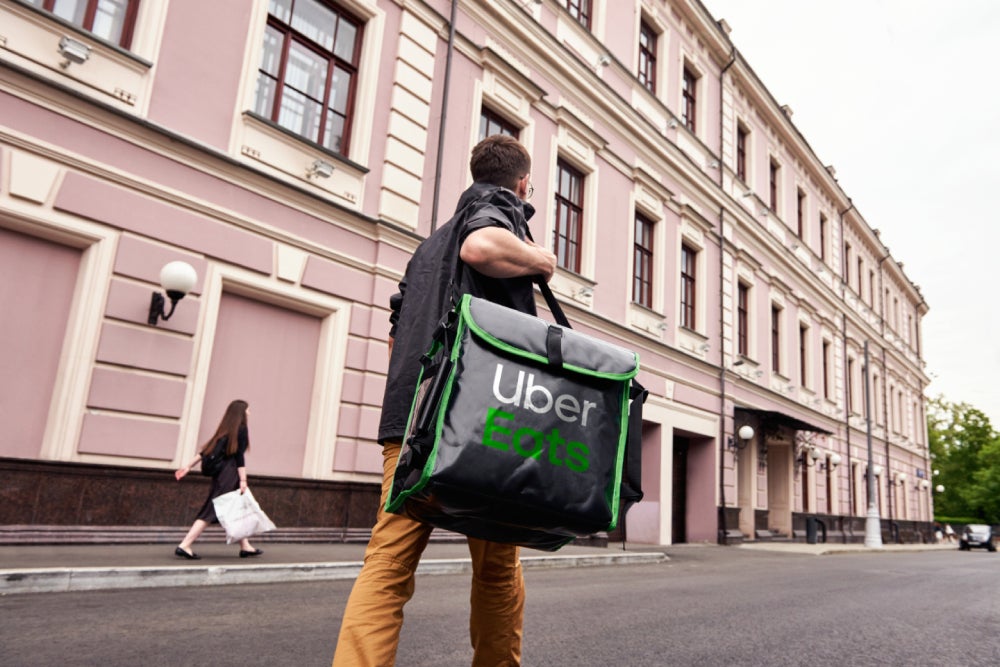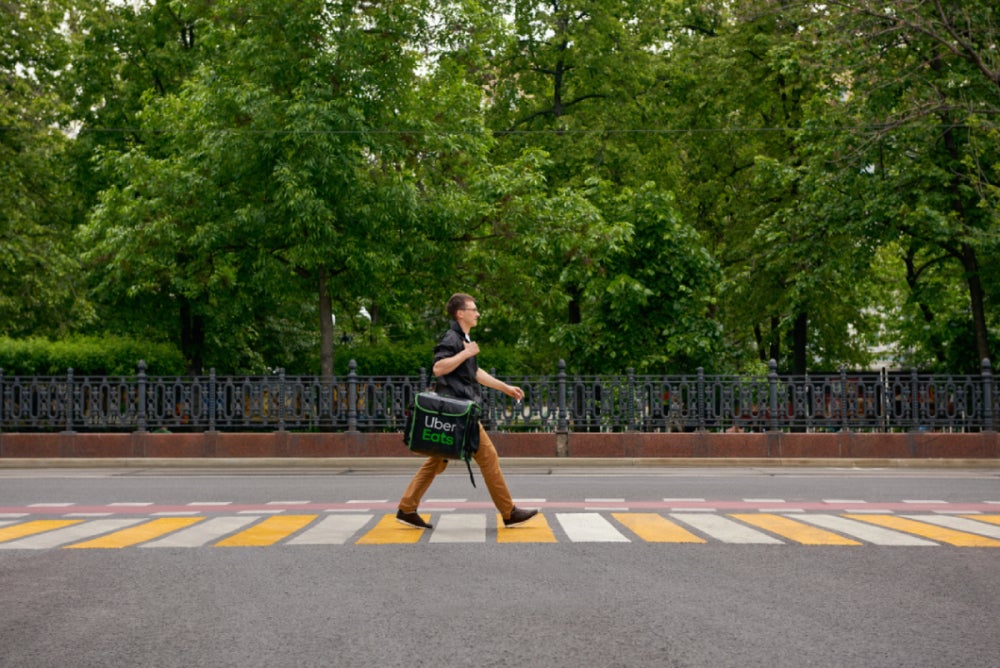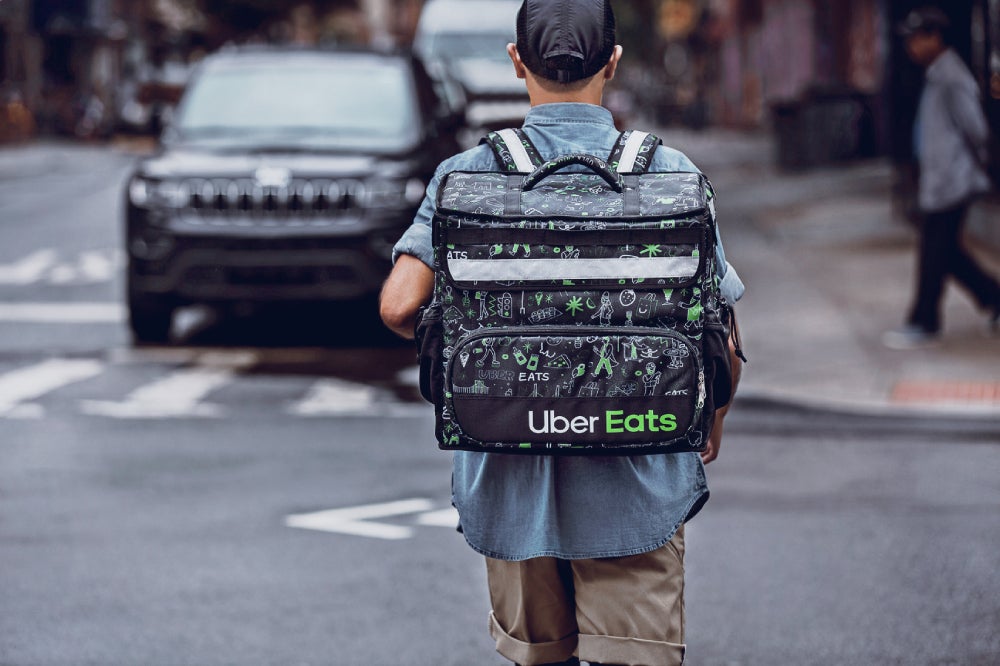
This year’s Tokyo Olympics, like each Olympiad before it, was a celebration of all things speed, the fastest runner or swimmer bespangled in medals. But just a few months before, the city of Tokyo began to host a pilot project from Uber Eats trialling walking couriers, making for a slower sort of food delivery than you might expect from gig workers.
This is coming at a time when the need for speed is perhaps galvanising the gig economy’s woes with contractors around the world, and, as Verdict discovers, such woes are making brands rather media-shy.
Currently consumers are used to couriers from food delivery apps such as Deliveroo and Just Eat arriving at their door by bike, scooter or car at a convenient pace. The Tokyo experiment though, as Verdict learns from Uber Eats Japan, is a new way for it to help ensure ramen, burgers and more are delivered quickly and efficiently in densely-populated cities such as the Japanese capital. But why would Tokyo or any other city similarly chugging with cars, trains and an efficient subway have a need for these so-called Uber Walkers? The answer is all down to infrastructure and a diversity in gig workers.
“Walking can be quicker and more efficient than riding a bike for short-distance trips because of narrow streets, stairs and the need to find the right parking space,” says a spokesperson for Uber Eats Japan. “Given the scale at which we operate, delivery on foot is becoming an interesting option.
“The pilot is also widening the access to earning opportunities for delivery partners. People who don’t own a bicycle can start delivering on Uber Eats simply by walking. People who currently deliver by bike are able to switch between bike and walking on their app before going online,” they tell Verdict.
It seems the infamous sprawling nature of Tokyo that might make one think it’s best navigated on wheels, not foot, is also why the service has been tried out there since June. After all, Asian capitals don’t have the sort of grid planning often seen in the West, with residences instead stacked high along the sides of higgledy-piggledy avenues, and some suburbs away from main roads and accessible only by step streets. Address systems can also be a headache to unpick for couriers speeding by in transit, especially if they’re not local.
How well do you really know your competitors?
Access the most comprehensive Company Profiles on the market, powered by GlobalData. Save hours of research. Gain competitive edge.

Thank you!
Your download email will arrive shortly
Not ready to buy yet? Download a free sample
We are confident about the unique quality of our Company Profiles. However, we want you to make the most beneficial decision for your business, so we offer a free sample that you can download by submitting the below form
By GlobalDataGig workers as walkers
This is perhaps why the walker model is becoming more of a trend in Asian food delivery. South Korea has seen walking couriers rolled out this year by brands such as Coupang Eats and convenience store giant GS25. Foodpanda is doing the same for Malaysia with so-called Pink Walkers, and GrabFood is putting on its best walking shoes in both Singapore and the Philippines.
Uber Eats Japan itself first tried out a walking pilot in 2017, perhaps paving the way for pedestrian gig workers in the Asian food sector. But it isn’t just Asia where Uber Eats, also known as UberEats, is invading sidewalks. The company has offered an on-foot option in both New York City and Toronto within the last year.
“Walker options may also prove their long-term popularity in cities that are notorious for traffic congestion,” says George Henry, associate analyst at GlobalData.
“UberEats’ walkers are offered short trips typically between 1 or 2 kilometres but have the option of riding a bike whenever they choose. This enables a greater degree of flexibility to carry out deliveries and complete orders at a faster rate.
“This makes the walking option ideally suited to dense urban environments, particularly at a time when governments consider and implement congestion charges to minimise non-essential vehicle usage.”
Traffic and regulatory intervention is a story seen from East to West, especially as governments become more conscious of emission targets. But what’s unique about Asia is the diversity of its walking couriers. As far back as 2017, Uber Eats meals were being delivered in Singapore by walking grandmothers. Korea’s GS25 meanwhile is targeting not just youth and students, but “older people, housewives and office workers” to participate in its on-foot delivery service offering both food and products.
As for the Uber Eats experiment, the company tells Verdict that it is still collecting and analysing data on the demographics of its walking couriers this year, but its spokesperson in Japan could confirm “that a wide range of delivery partners – people in their 20s to 60s – have already delivered on foot” through the Tokyo walker program.
It’s also possible Uber Eats will trial the service in other large Japanese cities, and also implement it as a permanent feature in Tokyo. The room for expansion is there, and fits in with a sea change occurring in the gig economy.
“We are seeing a more visible gig economy than ever before,” says GlobalData’s Henry. “The pandemic has forced people of all ages to consider gig work as a means to supplement their incomes. The high turnover rate, or ‘churn’, does not pose a financial risk to platforms that have zero capital invested in individual workers since they use their own equipment.”
Where next for the gig economy?
When one considers that there’s no need for equipment to walk and a higher road accident risk when couriering food on two wheels or four, a high risk at that in Asia, and the rise in walkers becomes easy to explain. What’s more difficult to unpick is where this path leads to for the gig economy, even if online food delivery is booming and likely to stay that way: a GlobalData report on online food delivery predicts the food and grocery online retail market to grow at a significant 20% compound annual growth rate (CAGR) from 2019 to 2023, compared to the whole food and grocery retail market growing at a CAGR of 5% within the same period.
“Faced with dramatic consumer behaviour changes over the past year, foodservice outlets have deployed a range of techniques to induce repeat custom,” says Henry. “Concerns around virus transmission have also prompted foodservice companies to pivot away from dine-in hospitality and move towards delivery services.
“Consumer trends for quick commerce have notably accelerated during the Covid-19 pandemic as people stay at home and desire products on-demand,” Henry continues. “A huge number of quick commerce apps have attempted to capitalize on this by recruiting extra couriers to fulfil deliveries.”
While a boon to the tech world’s marketplace of delivery apps, the Covid crisis has been playing out against a backdrop of increasing backlash against the gig economy and Big Tech treatment of workers in general. It’s hard to forget Deliveroo’s debut on the London Stock Exchange flopping this year due to investor concerns over its employee model. Both Deliveroo and Uber have been in and out of court in both the UK and US in efforts to settle the status of their workers as employees or as self-employed.
“For as long as companies and courts continue to battle over definitions, improved incentives will remain the key factor for platforms to build better relationships with their workers,” says Henry. “In many cases, it may not even be higher pay, but a safety net that provides workers with a feeling of value.”
“Regulations, however, have failed to keep pace with the speed of structural changes in employment, making it difficult for workers to receive labour protections they feel they deserve.”
While Amazon may grab headlines in the West with stories of its gruelling working conditions and union bashing, it’s the same story in the APAC region when it comes to Big Tech giving arguably little attention to employee rights. The so-called Amazon of Korea for example, Coupang, has seen work-related injuries and illnesses at the company and its warehouses double in one year. Labour activists have also claimed there have been deaths due to overwork, and two parcel delivery workers for the firm have died within the month this year whilst on the job. Such couriers are classified as self-employed in South Korea.
Hungry Panda meanwhile was beaten in Australian courts this spring and forced to reverse pay cuts for couriers, along with providing insurance for riders in the event of injury or death. The company, along with rivals such as Uber Eats and Door Dash, had seen riders die within two months on Australian roads at the start of this year, prompting parliamentary concern. GrabFood has seen similar tragedies in both Singapore and Thailand.
Such an epidemic may explain why media requests from Verdict for this feature were met with communication staff from multiple and entirely separate brands asking the journalist for initial conversations via video call to discuss the article in depth before any further action. In each case the journalist had already clearly defined the article by email, along with the sending of rudimentary questions on their services.
Verdict decided therefore not to indulge each brand’s video conference requests, which prompted them all to break contact thereafter. Such a request, readers should know, is unusual, especially when the conversations are to be off-the-record.
In this case, a simple refusal to provide comment may have worked better for all parties.
The future of foodservice
What this may all mean is that food delivery brands making use of gig workers are spooked in the current climate, with corporate conduct becoming an increasingly significant investor concern and courts and regulators moving to take action around the world.
Food delivery brands making use of gig workers are spooked in the current climate, with corporate conduct becoming an increasingly significant investor concern.
That jitteriness may also be seen as a reason why walking services may appeal to some brands, making as they do for a safer mode of journey which relies on less commitment from couriers. A walking courier is, after all, likely to do fewer hours than one who’s driving, and will need less insurance cover if classified as an employee. Henry though isn’t so sure this is the future for food delivery.
“As consumers expect increasingly quicker deliveries, walkers may only secure long-term popularity with immobile or older customers that would otherwise struggle to collect their order,” he says. “As couriers tend to earn more for travelling more miles, walkers are hindered by the short distances that are relatively cost ineffective and time consuming.”
In Henry’s view, food delivery’s future will continue to be defined by the events of 2020 and changes already taking place in the West, noting that “throughout the pandemic, quick commerce and on-demand activity accelerated to the extent that some brands resorted to platform integration, combining foodservice with retail deliveries.”
Brands such as Uber Eats are already delivering groceries from local convenience stores alongside the usual restaurant wares, leading to wider choice for the consumer. Conversely, some brands are offering less, as it turns out.
“Some foodservice companies have downsized menus and retail space to focus on a core selection and takeout delivery. Last year, Taco Bell removed 12 menu items in an attempt to provide ‘a more efficient Taco Bell experience’”, Henry points out.
The analyst adds that, for all its battles with gig workers in the courtroom, Deliveroo is still the one to keep an eye on in the UK market, one which, it should be noted, has yet to see walking services emerge. The London-headquartered brand has already expanded into around 100 new UK towns and cities this year for starters, meaning it’s no longer exclusive to London and regional capitals.
“Ultimately, Deliveroo’s value proposition centres around convenience, quick delivery, and partnerships with a wide range of high-quality foodservice outlets.
“The influx of new delivery operators has prompted Deliveroo to leverage its courier network to ensure an average delivery time of 32 minutes, a time that competitors struggle to consistently match.”
As ever then, it seems that the race mostly goes to the quick in food delivery, but there’s no reason why walking couriers can’t be a part of that when it comes to traversing a big city’s nook and crannies.
The road to regulatory and legal redemption will be harder for gig-worker companies to navigate, though.
By Verdict’s Giacomo Lee. Find out more in GlobalData’s Thematic Research Online Food Delivery report.





